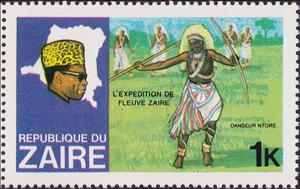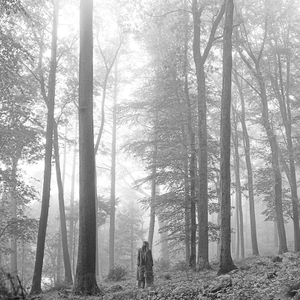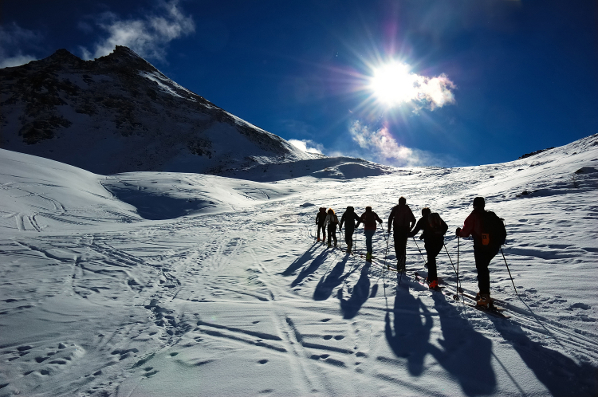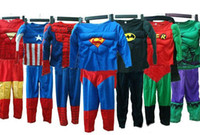Stamp: Ntore-dancer (Zaire 1979)
Ntore-dancer (Zaire 1979)
12 February (Zaire ) within release Discovery of the River Zaïre goes into circulation Stamp Ntore-dancer face value 1 Zairean makuta
| Stamp Ntore-dancer in catalogues | |
|---|---|
| Michel: | Mi:CD 589 |
| Stamp Number: | Sn:CD 902 |
| Yvert et Tellier: | Yt:CD 926 |
| Belgium: | Bel:CD 967 |
Stamp is horizontal format.
indigenous dancerAlso in the issue Discovery of the River Zaïre:
- Souvenir Sheet - Expedition On River Zaire face value 18;
- Souvenir Sheet - The voyage of discovery of the River Zaïre face value 106;
- Stamp - Ntore-dancer face value 1;
- Stamp - Regal Sunbird (Nectarinia regia) face value 3;
- Stamp - African Elephant (Loxodonta africana) face value 4;
- Stamp - Diamond, cotton & tobacco face value 10;
- Stamp - Hand with torch face value 14;
- Stamp - Lion (Panthera leo), Water Lily face value 17;
- Stamp - Waterfalls of Inzia face value 25;
- Stamp - Fishermen of Wagenia face value 50;
- Stamp - African Elephant (Loxodonta africana) face value 4;
- Stamp - Diamond, cotton & tobacco face value 10;
- Stamp - Fishermen of Wagenia face value 50;
- Stamp - Hand with torch face value 14;
- Stamp - Lion (Panthera leo), Water Lily face value 17;
- Stamp - Regal Sunbird (Nectarinia regia) face value 3;
- Stamp - Waterfalls of Inzia face value 25;
- Souvenir Sheet - Expedition On River Zaire face value 18;
|
Data entry completed
83%
|
|
|---|---|
| Stamp Ntore-dancer in digits | |
| Country: | Zaire |
| Date: | 1979-02-12 |
| Size: | 52 x 33 |
| Perforation: | 14 |
| Format: | Stamp |
| Face Value: | 1 Zairean makuta |
Stamp Ntore-dancer it reflects the thematic directions:
A head of state (or chief of state) is the public persona that officially represents the national unity and legitimacy of a sovereign state. In some countries, the head of state is a ceremonial figurehead with limited or no executive power, while in others, the head of state is also the head of government. In countries with parliamentary governments, the head of state is typically a ceremonial figurehead that does not actually guide day-to-day government activities and may not be empowered to exercise any kind of secular political authority (e.g., Queen Elizabeth II as Head of the Commonwealth). In countries where the head of state is also the head of government, the president serves as both a public figurehead and the actual highest ranking political leader who oversees the executive branch (e.g., the President of the United States).
A map is a symbolic depiction emphasizing relationships between elements of some space, such as objects, regions, or themes. Many maps are static, fixed to paper or some other durable medium, while others are dynamic or interactive. Although most commonly used to depict geography, maps may represent any space, real or imagined, without regard to context or scale, such as in brain mapping, DNA mapping, or computer network topology mapping. The space being mapped may be two dimensional, such as the surface of the earth, three dimensional, such as the interior of the earth, or even more abstract spaces of any dimension, such as arise in modeling phenomena having many independent variables. Although the earliest maps known are of the heavens, geographic maps of territory have a very long tradition and exist from ancient times. The word "map" comes from the medieval Latin Mappa mundi, wherein mappa meant napkin or cloth and mundi the world. Thus, "map" became the shortened term referring to a two-dimensional representation of the surface of the world.
Folklore is the body of expressive culture shared by a particular group of people; it encompasses the traditions common to that culture, subculture or group. These include oral traditions such as tales, proverbs and jokes. They include material culture, ranging from traditional building styles to handmade toys common to the group. Folklore also includes customary lore, the forms and rituals of celebrations such as Christmas and weddings, folk dances and initiation rites. Each one of these, either singly or in combination, is considered a folklore artifact. Just as essential as the form, folklore also encompasses the transmission of these artifacts from one region to another or from one generation to the next. For folklore is not taught in a formal school curriculum or studied in the fine arts. Instead these traditions are passed along informally from one individual to another either through verbal instruction or demonstration. The academic study of folklore is called folkloristics.
Dance is an art form, often classified as a sport, consisting of sequences of body movements with aesthetic and often symbolic value, either improvised or purposefully selected. Dance can be categorized and described by its choreography, by its repertoire of movements or by its historical period or place of origin. Dance is typically performed with musical accompaniment, and sometimes with the dancer simultaneously using a musical instrument themselves.
Exploration is the process of exploring, an activity which has some expectation of discovery. Organised exploration is largely a human activity, but exploratory activity is common to most organisms capable of directed locomotion and the ability to learn, and has been described in, amongst others, social insects foraging behaviour, where feedback from returning individuals affects the activity of other members of the group.
In clothing, a suit is a set of garments made from the same cloth, usually consisting of at least a jacket and trousers. Lounge suits (also known as business suits when sober in colour and style), which originated in Britain as country wear, are the most common style of Western suit. Other types of suit still worn today are the dinner suit, part of black tie, which arose as a lounging alternative to dress coats in much the same way as the day lounge suit came to replace frock coats and morning coats; and, rarely worn today, the morning suit. This article discusses the lounge suit (including business suits), elements of informal dress code.






